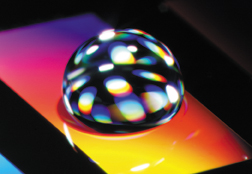Nanotechnologists have created a remarkably effective liquid-repelling surface that can also become, at the flick of a switch, a welcome mat for liquids. The ability to go from dry to wet and back on command makes the surface potentially useful for manipulating solutions in microchip chemical laboratories and many other devices, the material’s developers say.


The new surface is made from ordinary silicon. Its liquid-shunning property emerges when the scientists etch the wafer to create an array of pillars only hundreds of nanometers in diameter and then apply a thin, Teflonlike coating, report physicist Tom N. Krupenkin and his colleagues of Lucent Technologies’ Bell Labs in Murray Hill, N.J.
Perched on this “nanograss,” a liquid encounters nothing but a few unwelcoming pillar tips and usually forms beads, Krupenkin explains (SN: 11/1/03, p. 278: Available to subscribers at Water Repellency Goes Nano: Carpet of carbon nanotubes cleans itself). If the researchers apply about a 20-volt potential between the silicon surface and the liquid, however, the nanograss becomes fluid friendly, so that some liquids will soak in. Krupenkin described the new material on March 26 at a physics meeting in Montreal.
Future microchips may sport nanograss patches that can be electrically triggered to absorb or excrete drops of chemicals or even roll drops from patch to patch, Krupenkin says. Such patches could manipulate fluids in chip-scale genetic-testing labs, or they might deliver coolant to hot spots on microcircuits, Krupenkin suggests.





